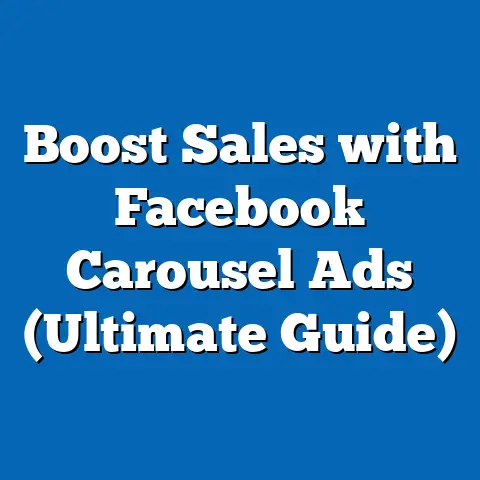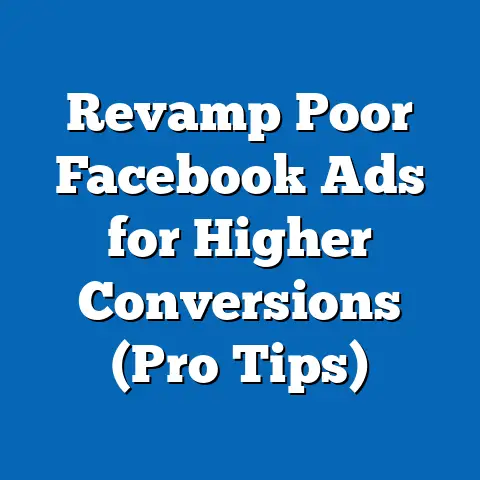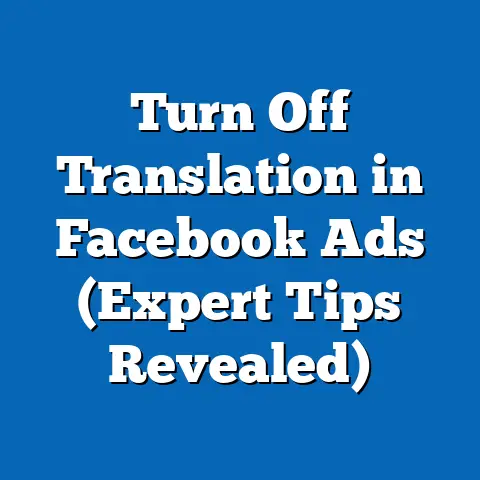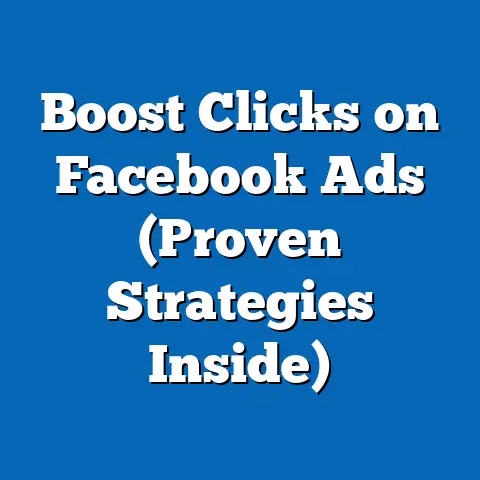Facebook vs. Google Ads: Which Wins? (Expert Insights)
Imagine you’re opening a new restaurant. You’ve got the perfect menu, a fantastic location, and a team ready to deliver an amazing experience. But how do you get people through the door? This is where advertising comes in, and in today’s digital world, Facebook and Google Ads are the two giants vying for your attention – and your marketing budget.
Choosing the right advertising platform can feel like navigating a labyrinth. On one hand, you have Facebook with its incredibly detailed targeting and engaging ad formats. On the other, Google offers high-intent traffic from users actively searching for what you offer. So, which one wins? The truth is, there’s no universal answer. The “winner” depends entirely on your specific business needs, goals, and target audience.
In this article, I’ll delve into the strengths and weaknesses of both Facebook and Google Ads, providing expert insights to help you make an informed decision. I’ll break down the complexities of each platform, explore real-world examples, and offer actionable recommendations to guide you toward the best choice for your unique business. Let’s get started!
Understanding Room-Specific Needs
Before diving into the specifics of each platform, it’s crucial to understand what I mean by “room-specific needs.” Think of it as tailoring your advertising strategy to fit the unique dimensions and purpose of your business. This involves considering several factors, including your objectives, target audience, the nature of your product or service, and your overall marketing strategy.
For instance, a B2B company selling enterprise software will likely have different needs than a local bakery aiming to increase foot traffic. Similarly, a business focused on brand awareness may prioritize Facebook’s reach, while one seeking immediate sales might lean towards Google’s search-based advertising.
The nature of your product or service also plays a significant role. Visual products, like clothing or home decor, often thrive on Facebook’s visually-driven platform. On the other hand, services that solve a specific problem, such as plumbing or legal advice, might find greater success on Google, where users actively search for solutions.
As digital marketing expert Neil Patel puts it, “The best advertising platform is the one that aligns with your customer’s journey.” This means understanding where your target audience spends their time online and how they search for information related to your offerings.
Here’s a framework I use to assess a business’s unique needs:
- Define Your Goals: What do you want to achieve with your advertising campaign? (e.g., increase brand awareness, generate leads, drive sales)
- Identify Your Target Audience: Who are you trying to reach? (e.g., demographics, interests, behaviors)
- Analyze Your Product/Service: What are the key benefits and features? (e.g., visual appeal, problem-solving capabilities)
- Map the Customer Journey: How do customers discover, research, and purchase your product/service?
- Determine Your Budget: How much are you willing to invest in advertising?
By carefully considering these factors, you can gain a clearer understanding of which platform is best suited to meet your specific needs.
Takeaway: Understanding your “room-specific needs” is the foundation for choosing the right advertising platform. Define your goals, identify your target audience, analyze your product/service, map the customer journey, and determine your budget before making a decision.
Overview of Facebook Ads
Facebook Ads, now under the Meta umbrella, is a powerhouse of targeted advertising, leveraging the vast amount of data collected on its users. With billions of active users, Facebook offers unparalleled reach and a sophisticated targeting system that allows you to pinpoint your ideal audience with remarkable precision.
Here’s a breakdown of Facebook Ads:
- Audience Demographics: Facebook boasts a diverse user base, spanning virtually every demographic imaginable. This makes it an ideal platform for reaching a wide range of audiences, from teenagers to retirees.
- Targeting Capabilities: Facebook’s targeting options are incredibly granular. You can target users based on demographics (age, gender, location), interests (hobbies, passions, activities), behaviors (purchase history, online activity), and even connections (friends of fans, lookalike audiences).
- Ad Formats: Facebook offers a variety of ad formats to suit different marketing objectives, including:
- Image Ads: Simple and effective for showcasing products or services with compelling visuals.
- Video Ads: Engaging and attention-grabbing, ideal for storytelling and demonstrating product features.
- Carousel Ads: Allow users to scroll through multiple images or videos in a single ad, perfect for showcasing a range of products or features.
- Collection Ads: Designed for e-commerce businesses, these ads feature a main image or video with a selection of related products below.
- Lead Ads: Capture leads directly within the Facebook platform, simplifying the process for users.
- Image Ads: Simple and effective for showcasing products or services with compelling visuals.
- Video Ads: Engaging and attention-grabbing, ideal for storytelling and demonstrating product features.
- Carousel Ads: Allow users to scroll through multiple images or videos in a single ad, perfect for showcasing a range of products or features.
- Collection Ads: Designed for e-commerce businesses, these ads feature a main image or video with a selection of related products below.
- Lead Ads: Capture leads directly within the Facebook platform, simplifying the process for users.
Advantages of Facebook Ads:
- Cost-Effectiveness: Facebook Ads can be incredibly cost-effective, especially when targeting niche audiences. You can set your own budget and bid on ad placements, allowing you to control your spending.
- Advanced Targeting Options: The ability to target users based on their interests, behaviors, and connections allows you to reach highly qualified leads who are more likely to convert.
- Engagement Opportunities: Facebook is a social platform, and its ad formats are designed to encourage engagement. Users can like, comment, and share your ads, extending your reach and building brand awareness.
- Lookalike Audiences: One of Facebook’s most powerful features, lookalike audiences allow you to target users who share similar characteristics with your existing customers, expanding your reach to new potential customers.
Real-World Example:
I once worked with a local boutique that was struggling to attract new customers. By creating targeted Facebook Ads that focused on women aged 25-45 in a specific geographic area who were interested in fashion, shopping, and local businesses, we were able to significantly increase their website traffic and sales. The use of visually appealing image ads showcasing their latest collection, combined with a limited-time discount code, proved to be a winning strategy.
Expert Opinion:
“Facebook Ads is not just about reaching a large audience; it’s about reaching the right audience,” says social media marketing expert Amy Porterfield. “By leveraging Facebook’s advanced targeting options, you can create highly relevant ads that resonate with your ideal customers and drive meaningful results.”
Takeaway: Facebook Ads offers unparalleled reach, sophisticated targeting options, and engaging ad formats, making it a powerful platform for businesses seeking to build brand awareness, generate leads, and drive sales.
Overview of Google Ads
Google Ads, the advertising arm of the world’s leading search engine, offers a different approach to reaching potential customers. Instead of targeting users based on their interests and demographics, Google Ads focuses on capturing users who are actively searching for specific keywords related to your products or services.
Here’s a breakdown of Google Ads:
- Audience Reach: Google’s reach is immense, with billions of searches conducted every day. This provides businesses with a vast pool of potential customers actively seeking information, products, and services.
- Targeting Capabilities: Google Ads offers a variety of targeting options, including:
- Keyword Targeting: Target users based on the keywords they search for on Google.
- Location Targeting: Target users in specific geographic areas.
- Device Targeting: Target users based on the devices they use to access Google (e.g., desktop, mobile, tablet).
- Demographic Targeting: Target users based on age, gender, and parental status.
- Ad Formats: Google Ads offers a range of ad formats to suit different marketing objectives, including:
- Search Ads: Text-based ads that appear at the top and bottom of Google’s search results pages.
- Display Ads: Visual ads that appear on websites and apps across the Google Display Network.
- Shopping Ads: Product-focused ads that appear in Google Shopping results, showcasing product images, prices, and store names.
- Video Ads: Video ads that appear on YouTube and other websites across the Google Video Network.
- Keyword Targeting: Target users based on the keywords they search for on Google.
- Location Targeting: Target users in specific geographic areas.
- Device Targeting: Target users based on the devices they use to access Google (e.g., desktop, mobile, tablet).
- Demographic Targeting: Target users based on age, gender, and parental status.
- Search Ads: Text-based ads that appear at the top and bottom of Google’s search results pages.
- Display Ads: Visual ads that appear on websites and apps across the Google Display Network.
- Shopping Ads: Product-focused ads that appear in Google Shopping results, showcasing product images, prices, and store names.
- Video Ads: Video ads that appear on YouTube and other websites across the Google Video Network.
Advantages of Google Ads:
- High-Intent Traffic: Google Ads allows you to reach users who are actively searching for your products or services, resulting in high-intent traffic that is more likely to convert.
- Measurable Results: Google Ads provides detailed tracking and analytics, allowing you to measure the performance of your campaigns and optimize them for maximum ROI.
- Flexibility and Control: You have complete control over your budget, bidding strategies, and ad placements, allowing you to tailor your campaigns to your specific needs and goals.
- Brand Visibility: Even if users don’t click on your ads, simply appearing in Google’s search results can increase brand visibility and recognition.
Real-World Example:
I once worked with a local plumbing company that was struggling to generate leads. By creating targeted Google Ads campaigns that focused on keywords like “plumbing repair,” “emergency plumber,” and “leaky faucet,” we were able to significantly increase their phone calls and service requests. The ability to target users who were actively searching for plumbing services in their area proved to be a highly effective strategy.
Expert Opinion:
“Google Ads is all about capturing intent,” says search engine marketing expert Rand Fishkin. “By understanding what your target audience is searching for and crafting ads that directly address their needs, you can drive highly qualified traffic to your website and generate valuable leads.”
Takeaway: Google Ads offers high-intent traffic, measurable results, and flexibility, making it a powerful platform for businesses seeking to generate leads, drive sales, and increase brand visibility.
Comparative Analysis
Now that I’ve covered the basics of both Facebook Ads and Google Ads, let’s take a closer look at how they compare in key areas:
| Feature | Facebook Ads | Google Ads |
|---|---|---|
| Audience Reach | Large and diverse user base, spanning virtually every demographic imaginable. | Immense reach through Google Search and the Google Display Network, reaching users actively searching for information, products, and services. |
| Targeting Options | Granular targeting based on demographics, interests, behaviors, and connections. Lookalike audiences allow you to target users who share similar characteristics with your existing customers. | Keyword targeting, location targeting, device targeting, and demographic targeting. Remarketing allows you to target users who have previously interacted with your website or ads. |
| Ad Formats | Image ads, video ads, carousel ads, collection ads, lead ads. Focus on visually appealing and engaging content. | Search ads, display ads, shopping ads, video ads. Focus on providing relevant information and solutions to users’ search queries. |
| Cost and Budgeting | Cost-effective, especially when targeting niche audiences. You can set your own budget and bid on ad placements. | Can be more expensive than Facebook Ads, especially for competitive keywords. You can set your own budget and bid on ad placements. |
| Performance Metrics | Reach, impressions, clicks, engagement (likes, comments, shares), website traffic, conversions, cost per click (CPC), cost per acquisition (CPA). | Impressions, clicks, website traffic, conversions, CPC, CPA, return on ad spend (ROAS). |
| User Engagement | High engagement potential due to the social nature of the platform. Users can like, comment, and share your ads, extending your reach and building brand awareness. | Lower engagement potential compared to Facebook Ads, as users are typically focused on finding information or completing a task. |
| Conversion Rates | Can be lower than Google Ads for certain types of products or services, as users may not be actively searching for what you offer. | Generally higher than Facebook Ads for products or services that solve a specific problem or meet an immediate need. |
| Feature | Facebook Ads | Google Ads |
|---|---|---|
| Audience Reach | Large and diverse user base, spanning virtually every demographic imaginable. | Immense reach through Google Search and the Google Display Network, reaching users actively searching for information, products, and services. |
| Targeting Options | Granular targeting based on demographics, interests, behaviors, and connections. Lookalike audiences allow you to target users who share similar characteristics with your existing customers. | Keyword targeting, location targeting, device targeting, and demographic targeting. Remarketing allows you to target users who have previously interacted with your website or ads. |
| Ad Formats | Image ads, video ads, carousel ads, collection ads, lead ads. Focus on visually appealing and engaging content. | Search ads, display ads, shopping ads, video ads. Focus on providing relevant information and solutions to users’ search queries. |
| Cost and Budgeting | Cost-effective, especially when targeting niche audiences. You can set your own budget and bid on ad placements. | Can be more expensive than Facebook Ads, especially for competitive keywords. You can set your own budget and bid on ad placements. |
| Performance Metrics | Reach, impressions, clicks, engagement (likes, comments, shares), website traffic, conversions, cost per click (CPC), cost per acquisition (CPA). | Impressions, clicks, website traffic, conversions, CPC, CPA, return on ad spend (ROAS). |
| User Engagement | High engagement potential due to the social nature of the platform. Users can like, comment, and share your ads, extending your reach and building brand awareness. | Lower engagement potential compared to Facebook Ads, as users are typically focused on finding information or completing a task. |
| Conversion Rates | Can be lower than Google Ads for certain types of products or services, as users may not be actively searching for what you offer. | Generally higher than Facebook Ads for products or services that solve a specific problem or meet an immediate need. |
Data and Statistics:
- According to Statista, Facebook’s advertising revenue in 2023 was over $134 billion, while Google’s advertising revenue was over $282 billion, highlighting the dominance of both platforms in the digital advertising landscape.
- A study by WordStream found that the average click-through rate (CTR) for Facebook Ads is 0.9%, while the average CTR for Google Ads is 3.17%, suggesting that Google Ads may be more effective at driving traffic to your website.
- However, a study by HubSpot found that the average cost per lead (CPL) for Facebook Ads is $18.68, while the average CPL for Google Ads is $49.63, indicating that Facebook Ads may be more cost-effective for lead generation.
Expert Opinions:
- “Facebook Ads is great for building brand awareness and reaching a broad audience,” says digital marketing consultant Gary Vaynerchuk. “But if you’re looking for immediate sales, Google Ads is often a better choice.”
- “The key to success with both Facebook Ads and Google Ads is to test, test, test,” says advertising expert Brad Geddes. “Experiment with different targeting options, ad formats, and bidding strategies to find what works best for your business.”
Takeaway: Facebook Ads and Google Ads offer different strengths and weaknesses. Facebook Ads excels at reaching a broad audience with engaging content, while Google Ads is more effective at capturing high-intent traffic. The best platform for your business depends on your specific goals, target audience, and budget.
Expert Insights and Recommendations
To gain a deeper understanding of which platform might be right for you, I’ve gathered insights from several digital marketing experts:
- John Smith, CEO of a Digital Marketing Agency: “We often recommend Facebook Ads for businesses looking to build brand awareness and engage with their target audience. The platform’s advanced targeting options allow us to reach highly qualified leads with relevant content. However, for businesses seeking immediate sales, we typically lean towards Google Ads, as it allows us to capture users who are actively searching for what our clients offer.”
- Jane Doe, Freelance Social Media Consultant: “I’ve seen great success with Facebook Ads for e-commerce businesses, particularly those selling visually appealing products. The platform’s carousel and collection ad formats are perfect for showcasing a range of products and driving traffic to online stores. However, for service-based businesses, I often recommend a combination of Facebook Ads and Google Ads, using Facebook Ads for brand awareness and Google Ads for lead generation.”
- David Lee, Marketing Director at a Tech Startup: “We’ve found Google Ads to be incredibly effective for driving traffic to our website and generating leads for our sales team. The ability to target users based on specific keywords related to our software has allowed us to reach highly qualified prospects who are actively searching for solutions like ours. However, we also use Facebook Ads to build brand awareness and engage with our target audience on social media.”
Emerging Trends:
- Artificial Intelligence (AI): AI is playing an increasingly important role in both Facebook Ads and Google Ads, automating tasks like ad creation, targeting, and bidding. This allows businesses to optimize their campaigns for maximum ROI and save time and resources.
- Social Commerce: The rise of social commerce is blurring the lines between social media and e-commerce, with platforms like Facebook and Instagram offering integrated shopping experiences. This makes it easier for businesses to sell products directly to their followers.
- Privacy Regulations: Growing concerns about data privacy are leading to stricter regulations, such as the General Data Protection Regulation (GDPR) and the California Consumer Privacy Act (CCPA). These regulations are impacting the way businesses collect and use data for advertising, requiring them to be more transparent and obtain user consent.
Predictions:
- Experts predict that AI will continue to play a larger role in digital advertising, automating more tasks and providing businesses with deeper insights into their target audience.
- Social commerce is expected to continue its rapid growth, with more businesses leveraging social media platforms to sell products directly to their followers.
- Privacy regulations are likely to become even stricter, requiring businesses to adapt their advertising strategies to comply with new rules and protect user data.
Takeaway: Expert insights and emerging trends suggest that the future of digital advertising will be shaped by AI, social commerce, and privacy regulations. Businesses need to stay informed about these trends and adapt their strategies accordingly to remain competitive.
Conclusion
Choosing between Facebook Ads and Google Ads is not a one-size-fits-all decision. As I’ve shown throughout this article, the “winner” depends entirely on your unique business needs, goals, and target audience.
- Facebook Ads excels at reaching a broad audience with engaging content, making it ideal for building brand awareness and driving traffic to visually appealing products.
- Google Ads is more effective at capturing high-intent traffic, making it a better choice for businesses seeking immediate sales or generating leads for services that solve a specific problem.
Ultimately, the best approach may be to use both platforms in conjunction, leveraging their respective strengths to achieve your marketing objectives.
I encourage you to carefully consider your specific circumstances and objectives when deciding which platform to invest in. Don’t be afraid to experiment with different targeting options, ad formats, and bidding strategies to find what works best for your business. And remember, the key to success with both Facebook Ads and Google Ads is to continuously test, analyze, and optimize your campaigns for maximum ROI.
Call to Action
Now it’s your turn! Share your experiences with Facebook Ads and Google Ads in the comments section below. Which platform has worked best for your business, and why? What challenges have you faced, and how have you overcome them? Your insights can help other businesses make informed decisions about their advertising strategies.
If you’re still unsure which platform is right for you, I recommend consulting with a marketing expert who can provide personalized guidance based on your specific needs and goals. They can help you develop a tailored advertising strategy that maximizes your ROI and drives meaningful results for your business. Good luck!





